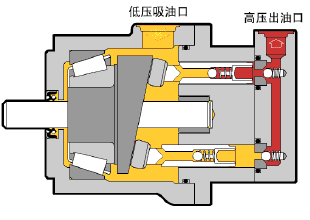The Working Principle of Hydraulic Pumps in Excavators
 Posted on 08/08/2022
Posted on 08/08/2022
The hydraulic pump in an excavator is a key component of the hydraulic system, which converts mechanical energy into hydraulic energy for performing various excavation and operation tasks. The following is a detailed introduction to the working principle of hydraulic pumps in excavators:

Energy input:
Hydraulic pumps are usually powered by the main power source of excavators, such as diesel engines. The engine transmits power to the input shaft of the hydraulic pump through a connecting system.
Suction stage:
The operation of the hydraulic pump begins in the suction stage. When the input shaft of the hydraulic pump rotates, it creates a low-pressure area that draws liquid (usually hydraulic oil) from the oil tank or return line through the suction port. This suction process causes the liquid to be introduced into the hydraulic pump.
Compression stage:
Once the liquid is sucked into the hydraulic pump, the working components of the hydraulic pump begin to compress the liquid. Hydraulic pumps can adopt different designs, including gear pumps, plunger pumps, vane pumps, etc., but their common goal is to compress the liquid into a high-pressure state.
Gear pump: A gear pump uses a pair of gears (drive gear and driven gear) to push the liquid and compress it.
Plunger pump: Plunger pump uses a plunger (piston) to move inside the cylinder and compress the liquid.
Vane pump: Vane pump uses rotating blades to compress liquid.
Liquid discharge:
The compressed liquid is forced out of the hydraulic pump and transmitted through the output pipeline of the hydraulic system. This will create high-pressure liquid in the hydraulic system. High pressure liquid enters the hydraulic cylinder, hydraulic motor, and other hydraulic actuators of the excavator through hydraulic pipelines, used to control various tasks of the excavator, such as lifting the stick, controlling the swing of the stick, and driving the walking device.
Circulation process:
The hydraulic pump continuously repeats the above suction, compression, and discharge processes to maintain high-pressure liquid in the hydraulic system. The liquid continuously circulates in the system to meet the hydraulic energy requirements of various parts of the excavator.
The working principle of hydraulic pumps is based on the incompressible nature of liquids, which can transmit force and create high pressure in the hydraulic system. Hydraulic pumps play a crucial role in construction machinery such as excavators, providing them with efficient, accurate, and powerful hydraulic energy, enabling them to perform various excavation and operation tasks. Different types of hydraulic pumps adopt different designs and working principles to adapt to different excavator models and working requirements.
Tags: Hydarulic Pump, Pump Working Principle, Piston Pump